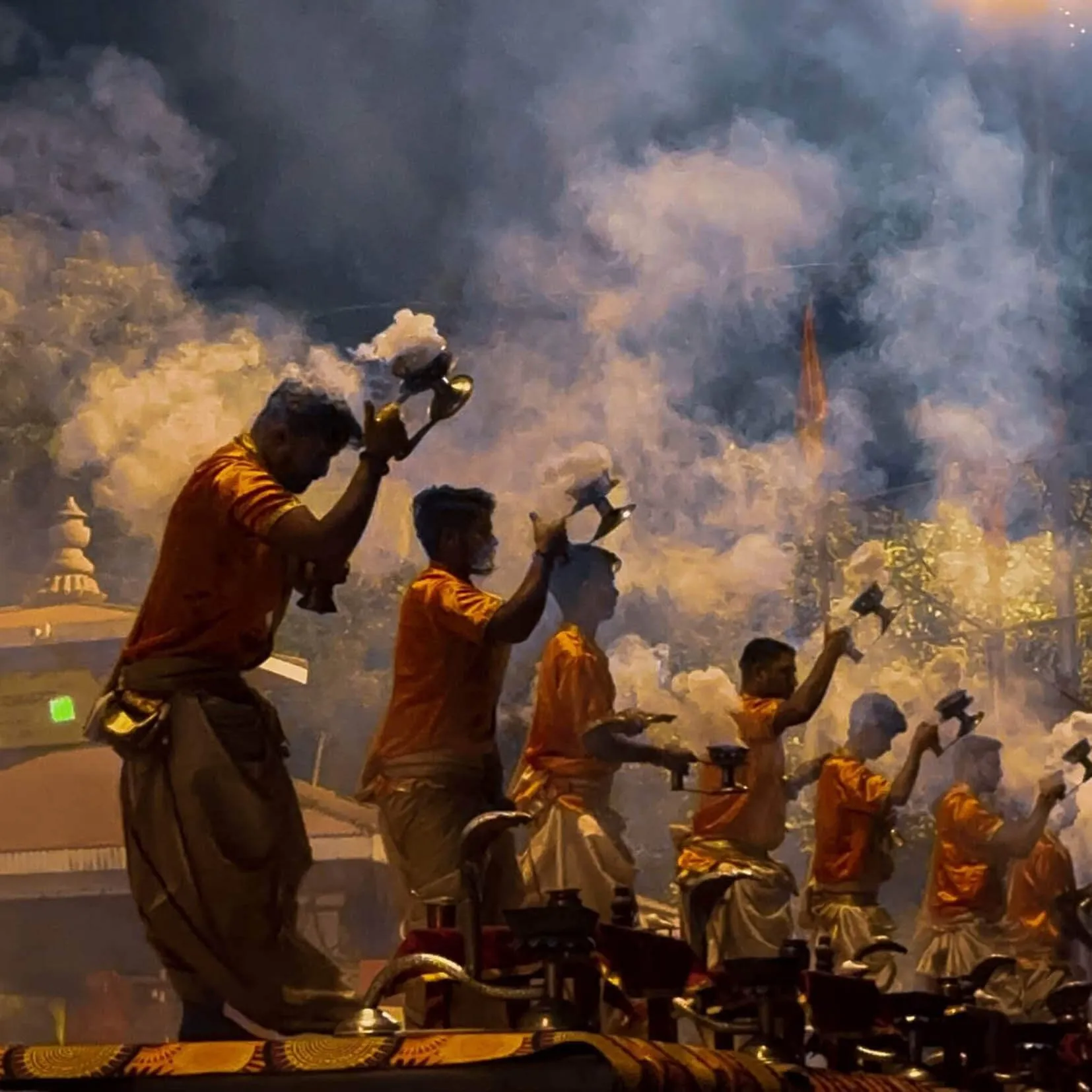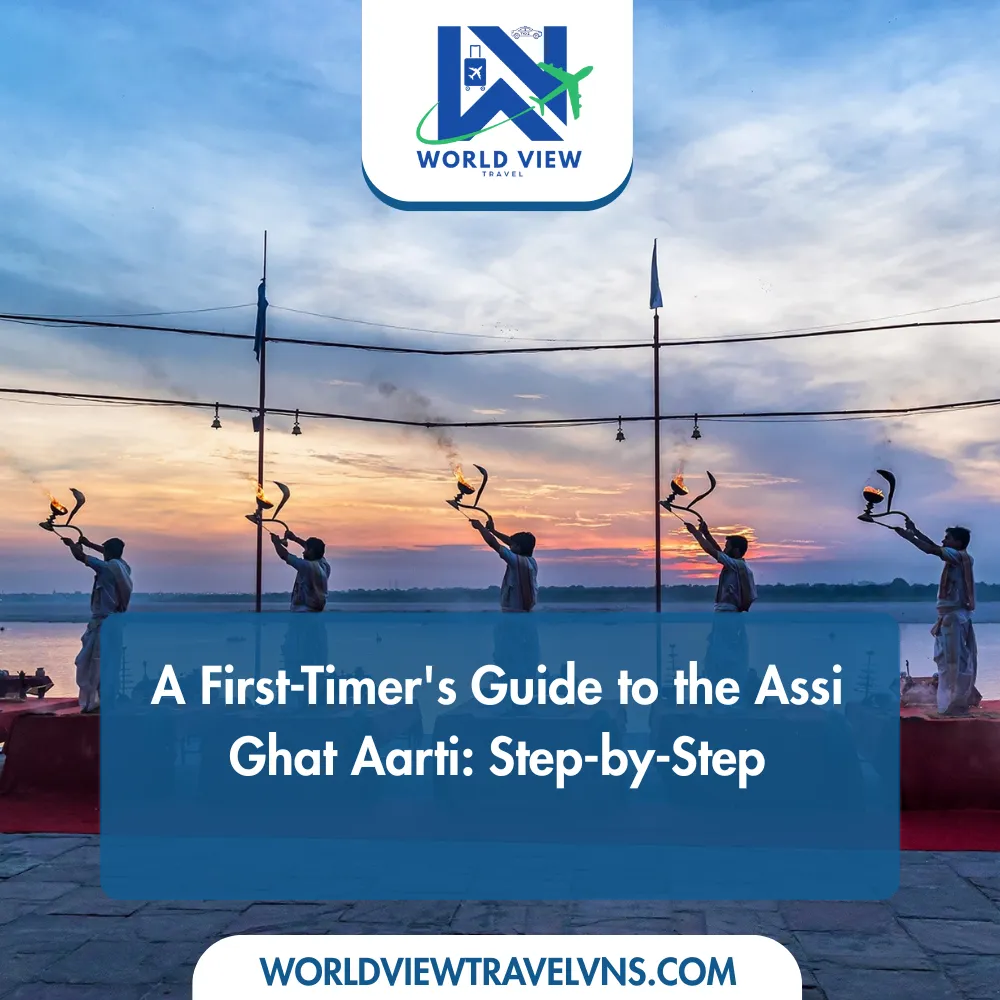A First-Timer’s Guide to the Assi Ghat Aarti: Step-by-Step
- MWS
- October 15, 2025
- No Comments
Varanasi’s Ganga Aarti is a profound immersion into the spiritual heartbeat of India. While many flock to the grand ceremony at Dashashwamedh Ghat, the aarti at the serene Assi Ghat offers a uniquely powerful and intimate connection to the ancient rituals. For a first-time visitor, knowing how to approach this experience can make all the difference.
This step-by-step guide will walk you through everything you need to know, from discovering the correct Assi Ghat aarti time to choosing the perfect viewing spot.
Table of Contents
Step 1: Know the Correct Aarti Time (Timing is Everything)
The first and most crucial step is understanding the schedule. The Ganga Aarti is not a fixed show; it’s a sacred ritual that follows the rhythm of the sun

Morning vs. Evening Aarti: What's the Difference?
Assi Ghat offers two completely different ceremonies each day.
Morning Aarti (Subah-e-Banaras)
- Atmosphere: Serene, peaceful, and cultural.
- What it is: A holistic 2-hour event to welcome the dawn.
- Activities: Includes Vedic chants, a sacred fire ritual (yajna), live classical music, and a public yoga session.
- Best for: Early risers and those seeking a deep cultural and spiritual start to their day.
Evening Ganga Aarti
- Atmosphere: Electric, vibrant, and devotional.
- What it is: An intense, 45-minute fire ceremony to thank the river Ganga.
- Activities: A visually stunning and synchronized ritual with large lamps, chants, and music.
Best for: First-time visitors and those wanting to see the iconic fire spectacle.
A Detailed Guide to Seasonal Aarti Timings
This table provides a complete overview of both ceremonies at Assi Ghat, helping you choose and plan your visit perfectly.
| Feature | Morning Aarti (Subah-e-Banaras) | Evening Ganga Aarti |
|---|---|---|
| Main Focus | A holistic cultural program with rituals, music, and yoga. | A traditional and spectacular devotional fire ceremony. |
| Summer Timings (March – October) | Starts approx. 5:30 AM | Starts approx. 6:30 PM – 7:00 PM |
| Winter Timings (November – February) | Starts approx. 6:00 AM | Starts approx. 5:30 PM – 6:00 PM |
| Total Duration | Approx. 90 – 120 minutes | Approx. 45 minutes |
| Recommended Arrival | 15-20 minutes before start time | At least 60 minutes before start time |
| Atmosphere | Serene, peaceful, inspiring, and less crowded. | Vibrant, energetic, mesmerizing, and bustling with people. |
| Cost | Free to attend on the ghat steps. | Free to attend on the ghat steps. Boat rides are extra. |
| Best For | Early risers, culture enthusiasts, and those seeking a peaceful spiritual experience. | First-time visitors, photographers, and those wanting to see the iconic fire spectacle. |
How to Find Today's Exact Aarti Time in Varanasi
For the precise time on the day of your visit, use these reliable methods:
- Ask a Local (The Gold Standard): This is the most accurate way. Your hotel concierge, a local guide, or any boatman at the ghat will know the exact time.
- Check the Sunset Time: Use a weather app to find the “sunset time in Varanasi” for the day. The evening aarti will begin 15-20 minutes after that time.
- Observe the Preparations: If you’re at the ghat, you’ll see the priests start setting up about an hour before the ceremony. When the crowd gathers, you know it’s about to start.
Arrive Early (The Golden Rule of Aarti)
After knowing the time, the next most important rule is to arrive early. This isn’t just about getting a good seat; it’s about soaking in the magical pre-aarti atmosphere.
Why Arriving 60 Minutes Early is Essential
- Secure a Prime Viewing Spot: Assi Ghat is spacious, but the best spots with a direct, unobstructed view are limited and fill up very fast.
- Soak in the Pre-Aarti Atmosphere: The hour before the aarti is magical. The “golden hour” light is perfect for photos, and you can watch the priests meticulously prepare for the ceremony.
- Provide a Buffer for the Unexpected: Varanasi is a city of delightful chaos. Arriving early means you won’t be stressed by a potential traffic jam or a wrong turn in the alleys.
What to Do and See While You Wait
- People-watch: Observe the fascinating mix of devout pilgrims, local families, and curious travelers from around the world.
- Observe the preparations: Watch the priests arrange the platforms and polish the large brass lamps.
- Take a short stroll: Walk along the ghat to see the neighboring temples and ashrams.
- Participate in a small ritual: Buy a diya (a small leaf bowl with a candle and flowers) from a vendor, make a wish, and release it onto the Ganga.
- Grab a hot chai: Enjoy a cup of lemon-ginger tea from one of the many roving chai-wallahs.
Choose Your Perfect Viewing Spot
Your perspective can shape your entire experience. Here are your three best options:
Option A: The Ghat Steps (For Full Immersion)
- The Experience: The most authentic way to watch. You’ll feel the vibrations of the chants, the heat from the lamps, and the powerful energy of the crowd.
- The Practicalities:
- Cost: Free
- Pro-Tip: Arrive at least 60 minutes early to get a central spot. Bring a scarf to sit on.
Option B: A Boat on the Ganga (For the Iconic View)
- The Experience: Offers a stunning, panoramic view of the entire ceremony with the ghats in the background. It’s a photographer’s dream.
- The Practicalities:
- Cost: Approx. ₹150-₹250 per person for a shared boat, or ₹1200-₹2000 for a private boat.
- Pro-Tip: Arrive 45 minutes early to negotiate the price and duration with a boatman before boarding.
Option C: A Rooftop Cafe (For Comfort and a Bird’s-Eye View)
- The Experience: A relaxed and comfortable option away from the crowds. It provides a unique, cinematic perspective of the ritual below.
- The Practicalities:
- Cost: The price of your food and drinks.
- Pro-Tip: Ideal for families with small children or those with mobility concerns. Visit a cafe in the afternoon to check their view and reserve a table.
Understanding the Rituals & Aarti
To truly appreciate the Ganga Aarti, it helps to understand the deep symbolism behind the ceremony and the basic etiquette for attending. This knowledge transforms you from a simple spectator into a respectful observer, allowing for a much richer experience. The aarti is a living tradition, a powerful form of Hindu worship called puja, where fire (Agni) is offered to the divine. Every element and action has a purpose, contributing to an atmosphere thick with devotion. Knowing what to look for and how to act will not only deepen your own understanding but also show respect for the performers and the many devotees for whom this is a sacred daily ritual.
The Symbolism Behind the Fire, Sound, and Incense
The Ganga Aarti is a symphony of symbolic elements, each representing a core aspect of the cosmos and devotion.
- Fire (Agni): The central element of the aarti is the flame from the large brass lamps (deepam). Fire represents the divine light of consciousness that dispels the darkness of ignorance. Its upward motion symbolizes the soul’s journey towards a higher state of being. As the priests move the lamps, they are not just creating a spectacle; they are weaving a protective shield of divine energy around the devotees.
- Sound (Shabda): The sounds of the aarti are not random noise. The loud boom of the conch shell (shankh) at the beginning represents the primal sound of creation, ‘Om’. The continuous ringing of bells and clashing of cymbals are designed to focus the mind, drown out distracting thoughts, and invite the divine to be present.
Incense (Dhupa): The fragrant smoke from the incense sticks represents the purification of the atmosphere and the self. As the smoke rises, it symbolically carries the prayers of the devotees up to the heavens
A Simple Guide to Aarti for Visitors
Following a few simple guidelines will ensure your presence is respectful and enhances the experience for everyone.
- Dress Modestly: As you are in a sacred space, it is best to wear clothes that cover your shoulders and knees.
- Remove Your Footwear: Before stepping onto the main area where the aarti is performed or where devotees are seated, you should remove your shoes. You can leave them to the side with many others.
- Be Mindful with Photography: While photography is allowed, avoid using a disruptive flash, which can distract the priests and other attendees. Find your spot and try to stay there rather than moving around and blocking the view of those seated behind you.
- Maintain a Respectful Silence: The chants and music are central to the ritual. Refrain from loud conversations during the ceremony to allow everyone to immerse themselves in the sacred sounds.
- Accepting Blessings: At the end of the aarti, priests may offer a blessing by cupping the flame. It is customary to gently waft your hands over the flame and bring them to your forehead, a gesture of receiving the divine light and purity.
Getting to Assi Ghat & What's Nearby
Planning your logistics for the Ganga Aarti time at Assi Ghat is straightforward, as it is one of the most famous and accessible ghats in Varanasi. Located at the southern end of the long chain of ghats, it marks the traditional boundary of the holy city. Its accessibility and the vibrant atmosphere surrounding it make it an ideal base for an evening in Varanasi. Assi Ghat is more than just a place for the aarti; it is a cultural hub, bustling with a unique blend of ancient tradition and modern, bohemian energy. It’s a favorite spot for long-stay travelers, researchers, and students, largely due to its proximity to the renowned Banaras Hindu University (BHU). This unique blend of energies means there is plenty to do and see before or after the aarti, allowing you to easily make a full evening of your visit. Whether you are coming from the main city, the cantonment area, or the narrow lanes of the old city, reaching Assi is relatively easy, and the lively environment ensures you will have a pleasant time exploring the area.
How to Reach Assi Ghat
Assi Ghat is well-connected and can be reached via the main road that runs parallel to the river, unlike many other ghats that are only accessible through narrow, winding alleys.
- By Auto-rickshaw or E-rickshaw: This is the most common way to travel. From anywhere in the city, you can hire an auto-rickshaw or a battery-operated e-rickshaw. Simply tell the driver “Assi Ghat.” They will drop you at the main road junction, from where it is just a short, two-minute walk down to the ghat steps.
- By Walking: If you are staying in the southern part of the old city, such as the Shivala or Bhadaini neighborhoods, a walk to Assi Ghat is a great option. Walking along the riverbank from the neighboring ghats like Tulsi Ghat or Bhadaini Ghat is a scenic and immersive experience.
By Boat: A classic Varanasi experience is to take a boat ride along the ghats. You can hire a boat from a more central ghat, like Dashashwamedh, and ask them to drop you at Assi Ghat in time for the evening aarti.
Exploring the Area Around the Ghat
Arriving early for the aarti gives you the perfect opportunity to explore the vibrant area surrounding Assi Ghat.
- Cafes and Restaurants: Assi Ghat is famous for its lively cafe culture. You’ll find numerous spots offering everything from traditional Indian food to international cuisines like Italian and Israeli. Many have rooftop seating with beautiful views of the Ganga.
- Bookshops and Boutiques: The area is dotted with charming little bookshops and boutiques selling local handicrafts, clothing, and spiritual items.
- Morning Boat Ride: While you’re there for the evening aarti, consider arranging a boat ride for the following morning. A boat trip at sunrise is one of the most popular and unforgettable Varanasi experiences.
Frequently Asked Questions (FAQs)
- No, the Ganga Aarti at Assi Ghat is completely free to watch from the ghat steps. You only pay if you choose to hire a boat.
- The ceremony itself lasts for approximately 45 minutes. However, plan to be there for about two hours in total to arrive early and get a good spot.
This depends on your preference. Dashashwamedh is larger and more spectacular. Assi Ghat is considered more intimate, less commercialized, and more deeply spiritual by many
- Your three best options are: arrive an hour early for a spot on the ghat steps, hire a boat for a panoramic view, or find a rooftop cafe for a comfortable perspective.
Subah-e-Banaras is the unique morning program at Assi Ghat. It is a two-hour event that includes Vedic chanting, a fire ritual, live classical music, and a public yoga session.
Yes, photography is allowed. However, be respectful, avoid using a disruptive flash, and try not to block others’ views once the ceremony begins.





